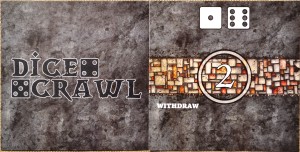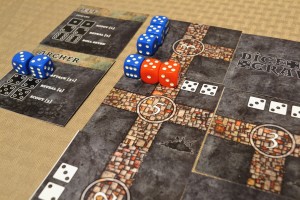I admittedly lack the pencil and paper RPG gene, even though I love dungeon crawlers…how odd is that? As a full-time accountant who also doubles as a full-time dad and the occasional games journalist, this is partially understandable. It can be hard sometimes to just sit down and play a game of “Chess”, let alone spend hours flipping through pages to try and create a character. “Dice Crawl”, I’m pleased to say, is perfect for my busy lifestyle. “Dice Crawl” is a dungeon crawler currently seeking your support on Kickstarter (as of 12/21/13), sporting plenty of dice and supporting up to four players. Before we take a sneak peek at what this game has to offer, I’d like to quickly thank Alyssa Faden from SoulJar Games for providing me with a prototype copy. It’s important to stress that prototypes are not usually representative of the final product, making everything featured below (including the rules) subject to change.
The game normally comes with four wooden player markers, forty-eight interchangeable dungeon tiles, four race cards, four class cards, four quick reference cards, and more dice than you can shake a stick at…though keep in mind that my prototype copy was missing the dice and player markers so I had to borrow from other games. Each race and class card has unique abilities on them (called powers), which can be used during the game to help give their owners a step up over the competition. The goal in this game will be to earn the most points, which can be accomplished through a few different means. Players will earn points by controlling tiles (the large number in the center of the tile) and by landing on the center tile (which also ends the game).
For a dungeon crawler, setting up the game is incredibly simple. Firstly, players will mix up the dungeon tiles and lay twenty-five of them out in a five by five grid face down. The rest of the dungeon tiles are returned to the box and won’t be used for the remainder of the game. Each player gets a random race and class tile, though they’ll be able to choose the player marker of a particular color. Once players have chosen a marker, they’ll receive twenty dice of that same color…twenty-five if they want an easier game. Once everyone has received everything they are supposed to, they’ll each place one of their markers on one of the corners of the grid (one player marker per corner).
A player can do a number of different things on their turn: Reveal/Scout, Crawl/Hoard, and Powers/Actions. It may sound a bit overwhelming, but the flow of play is actually very smooth once you get a few turns under your belt. Revealing allows a player to flip over an adjacent tile that they could legally move to, while scouting allows a player to move to an adjacent tile. It’s important to note that scouting can only occur (normally) when the tile that the player occupies is completely covered with armies (dice). If you take anything away from this, think of revealing and scouting as your means of moving through the dungeon and reaching the center.
Crawling/Hoarding is where the bulk of the game is, as it involves the player rolling five of their dice and choosing where best to put them…similar to that of a worker placement game. A player can place the dice they’ve rolled onto open numbers on the tiles occupied by player markers or opt to place dice onto the powers listed on their race/class cards. Once a player has unlocked a particular power by placing dice on it, they may activate it via their normal die roll on a future turn. Since a player only starts with twenty dice, players will need to take care when choosing where to place their dice…developing your character’s abilities means you’ll have less dice to place onto the dungeon tiles! A player needn’t place all of their dice on their turn.
Finally, a player can make use of the Powers/Actions ability. As mentioned above, each player will have their own race and class card, which comes with a unique set of abilities. These abilities must first be unlocked before they can be used…again, by placing dice on these cards/abilities via the Crawl/Hoard action. Some abilities have a permanent effect (passive), while others have a cost each time they are used (active). A player can pay the cost to use the latter by simply using one of their unrolled die…very useful for when rolls don’t favor the open spaces currently on the grid.
Players will continue taking turns until one person has revealed and moved onto the center tile, or when a player’s dice are all locked at the beginning of their turn. The person who does the former earns three points from the get go. Each player will then check each revealed tile to see who controls it…the player with the most dice on that tile will be awarded the points listed at its center. There are a few other spaces to consider, but that should give you the jist of it. The person who manages to control the most tiles will generally win the game, though some tiles are worth more than others forcing players to pay attention a bit.
While this game is still in the development phase, I must say that my time spent learning the ins and outs was thoroughly enjoyable. The power to place dice onto another tile (occupied by another player) is risky as it allows your opponent to move onto the next tile faster, though it may actually help to net you some points during the game’s end assuming you manage to have the majority count of dice at that location. Random race and class abilities also serve to mix things up…I was often at ends deciding on whether or not I should unlock an ability or save my precious dice for the purpose of controlling more tiles.
Is “Dice Crawl” worth supporting? In short, yes. “Dice Crawl’s” fast and furious gameplay style certainly suits me, though there’s still plenty to think about from turn to turn. Great for players of all ages and gamers of all types, this is one dice game you won’t want to let slip by.
—
You can learn more about and support “Dice Crawl” by visiting its Kickstarter page, here:
http://www.kickstarter.com/projects/1561867839/dice-crawl
—


